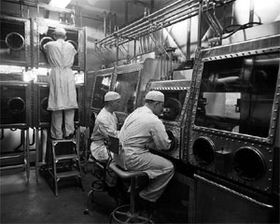利用者:Akaniji/封じ込め

封じ込め(ふう—こ—、biocontainment、laboratory biosafety)とは、実験室のバイオハザードによる感染事故や生態系破壊を防止するために行う拡散防止措置をいう。 封じ込めには物理的封じ込め (physical containment) と生物学的封じ込め (biological containment) がある。
概要
[編集]The concept of 封じ込め, also called 実験室バイオセーフティ, pertains to 微生物学実験室 in which the 物理的封じ込め of 高病原性生物 (細菌, ウイルス) is required, usually by 隔離 in environmentally and biologically secure cabinets or rooms, to prevent accidental 職員の感染 or 漏洩 into the 近隣 community during 科学研究. The term "biocontainment" was coined in 1985[1], but the concept stretches back at least to the 1940s.
1次封じ込め is the protection of personnel and the immediate laboratory environment from exposure to infectious agents and is provided by good microbiological technique and the use of appropriate safety equipment, such as biological safety cabinets. 2次封じ込め is the protection of the environment external to the laboratory from exposure to infectious materials and is provided by a combination of facility design and operational practices.
安全キャビネット are fairly common devices designed to provide effective 1次封じ込め in 実験室 working with 高感染性 agents. Three general levels and types have been devised (Class I, Class II, and Class III).
Biosafety suites are suites of 実験室 which are essentially equivalent to large Class III cabinets in which positive pressure personnel suits ("宇宙服") serve as the "outside" environment for workers. Examples include the biosafety suites at USAMRIID at Fort Detrick, Maryland and the Maximum Containment Facility (MCF) of the CDC in Atlanta, Georgia.
補習資料
[編集]- Biosafety in Microbiological and Biomedical Laboratories (1999), 4th Edition, U.S. Department of Health and Human Services, Public Health Service, Centers for Disease Control and Prevention, National Institutes of Health, Washington, DC: U.S. Government Printing Office.
関連項目
[編集]- バイオハザード
- バイオセーフティーレベル
- バイオセーフティ:封じ込めとほとんど同じ概念であるため、本項にリダイレクトされる。
- バイオセキュリティ
- 安全工学
- en:Security engineering:保安工学
- en:Select agent:アメリカ政府指定機関
参考文献
[編集]- ^ "Biocontainment”, Merriam Webster Online
